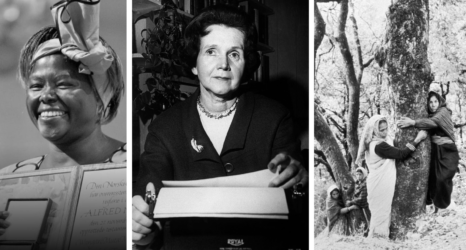My understanding of the Soviet Union and its satellite countries began with the nation’s dissolution.
The summer I turned seven, I watched on TV athletes from across the globe compete in the 1992 Summer Olympic Games. I remember my mother pointing out the Unified Team–the banner under which most former Soviet Republics competed in 1992–as they entered Barcelona’s Olympic Stadium.
“That’s the last time you’ll ever see the Soviet Union compete together,” she explained.
I understood that the world was changing because new maps, with different borders and names, arrived in my classroom before I left for summer vacation. As I moved through elementary school, one section of the map always shifted. A country called Yugoslavia broke into many pieces and rearranged itself, over and over again.
Téa Obreht’s extraordinary debut novel The Tiger’s Wife explores this Eastern European region’s ever-changing borders–through wars, regional myth, world history and internationally-known fiction. It centers on Natalia, a doctor who learns of her grandfather’s death as she drives with a friend to inoculate children at an orphanage across the border (the exact location is unknown, but one assumes the novel is set in and around Obreht’s native Belgrade). The author explores Natalia’s present through her grandfather’s past, particularly through two interweaving stories: the tiger’s wife and the deathless man.
Natalia’s grandfather grew up in Galina, a small, provincial village where he befriended the town’s apothecary, the “reliable magician,” the only type Natalia’s grandfather, who also becomes a doctor, “could ever admire.” The apothecary gives Natalia’s grandfather a copy of Rudyard Kipling’s The Jungle Book, which he then carries with him all his life. As he studies Kipling’s hand-drawn pictures, the boy is the only citizen of Galina to recognize the animal stalking the town, escaped from a bomb-stricken zoo, as a tiger.
The “tiger’s wife” is a deaf-mute Muslim girl, a victim of severe beatings by her legal husband–a butcher tricked into marrying her. She befriends the tiger and, the town believes, murders her husband. As the Germans advance on Galina (Yugoslavia was invaded by the Axis powers in World War II), the tiger and his wife become the scapegoats, the outsiders. The villagers, Obreht writes, “attached their anxious grief to the girl so they could avoid looking past her to what was coming.”
The fate of the tiger’s wife teaches Natalia’s grandfather, an orphan, to be skeptical of close-knit communities, of families who cling to superstition and tradition instead of pragmatism. And the deathless man forces Natalia’s grandfather to widen his perspective. Through this mythic figure–a man condemned to live forever while predicting the death of others–Natalia’s grandfather learns that while village myth and superstition can rend and divide, stories also unite communities and countries, across and around borders.
Obreht masterfully integrates myth and reality, allegory and history. Animals often serve as metaphor throughout her novel, just as they did throughout Kipling’s Jungle Book. The book opens with four-year-old Natalia and her grandfather at the zoo, visiting the tiger’s cage. Years later, during the bombing raids of a new war, a war that again begets new borders and nations while tearing historic communities apart, Natalia learns that the tiger turned on himself, gnawing his legs to the bone. The zookeeper, a man who imagined the tiger as family, is forced to murder the animal to save him from himself, a detail that serves as a powerful allegory for the region’s woes. “The man who raised him,” Obreht writes, “the man who nursed him, weighed him, gave him baths … pulled the trigger.”
Following the allegorical tradition, Obreht’s language is lyrically simple yet extremely evocative. Three villagers volunteer to hunt the tiger through the mountains around Galina, and they encounter the animal in this breathtaking description: “It was later afternoon when they came across the tiger in a clearing by a frozen pond, bright and real, carved from sunlight.”
As one of the New Yorker’s “20 Under 40,” Obreht has already garnered significant praise. The Tiger’s Wife represents an extraordinary accomplishment and I am thrilled to see that what many critics describe as the male-dominated publishing world has taken notice. It is well-deserved.





